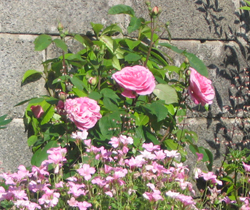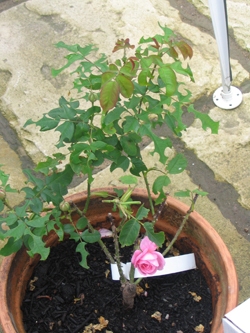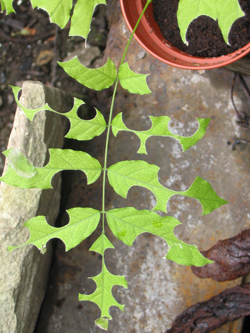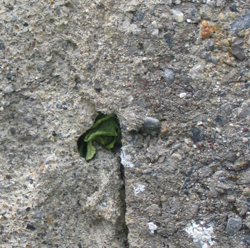A couple of months ago our friend Siobhan Denman gave us a present of two roses for our new garden.
One of the plants thrived and has produced an abundant crop of dense and sweet smelling roses,

the other one, which we planted close to it has been fairly stunted.
We noticed fairly early on that there seemed to be several holes in the leaves. These were very regular, semicircular holes which looked like they had been cut by an expert with a jig saw and a compass.

We assumed that this was some sort of vine weevil and so we moved the plant out of its site and into a pot to see if we could lose its parasite.
All went well for a few weeks and the rose was well on the way to recovery when the maniac hole cutter struck again.
At this stage we decided to abandon it to its (stunted) fate, and were just grateful that it was leaving the rest of the plants alone.
Then on Friday Sile brought home those plants which she had been growing for her pupils in school.
One of these was the shoots of the seeds of a strange Laburnum type plant which she had pocketed in the garden of Gualtiero Marchesi’s Restaurant in Ebrusco in Italy last September.
We left the pots with these seeds in the garden while we found lunch and when we came out again about 30 mts later we found that the leaf cutter had struck again.

This time we had obviously provided something utterly irresistible!
Sile headed off to the internet to see what the dickens we had, this was obviously not a weevil, unless it was a super charged one!
She found the following;
Leaf-cutting bees (Megachile species)
Plants affected
Many plants, but roses are a particular favourite.
Symptoms
Neat, elliptical segments are cut out of the leaf margins, particularly of roses. The adult bees are more hairy and broader than a honeybee. Leaf-cutting bee females are 10-15mm long and the underside of the abdomen is covered in ginger hairs. The nests are made in tunnels in rotten wood, hollow plant stems or in flower pots and seed trays, especially where the compost has dried out.
Cause
This is the work of leaf-cutting bees that use the leaf segments in the construction of their nests. Rose leaves are particularly favoured, but other plants are also used. The female bee carries one leaf piece at a time back to her nest.
Each thimble-shaped leaf cell is then stocked with a mixture of nectar and pollen on which the bee lays an egg, before capping the cell with circular pieces of leaf. The process is repeated until the nest may contain up to 20 cells. The nests are sometimes found when glasshouse plants are being repotted or old seed trays emptied; by then the leaves may have become greyish brown and the cells may contain white grubs which will pupate and emerge as adult bees the following year.
These bees are solitary with each female having her own individual nest that she constructs and provisions on her own. The females have stings but lack aggression and do not chase or sting people. Most plants tolerate the damage, although small plants may suffer a significant loss of leaf area. Nests in flower pots have little impact on the plant unless it is growing in a small pot.
So this was no weevil, but a bee doing some nest lining.
We watched the plant carefully and, sure enough we found the bee at his work and were able to follow it to its leaf lined nest in the wall

A learning experience this gardening!

Comments
The comments are closed.